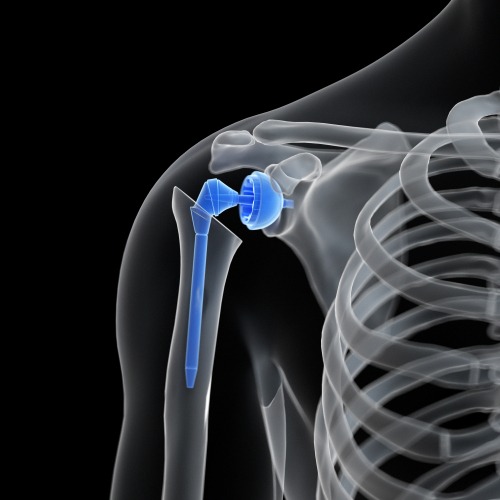Shoulder Replacement Surgery
 Thousands of traditional total shoulder replacements are carried out every year successfully in the US for patients suffering from shoulder arthritis. However, this type of surgery is not beneficial in patients with large rotator cuff tears, which have caused cuff tear arthropathy.
Thousands of traditional total shoulder replacements are carried out every year successfully in the US for patients suffering from shoulder arthritis. However, this type of surgery is not beneficial in patients with large rotator cuff tears, which have caused cuff tear arthropathy.
Conventional total shoulder replacement may not be able to alleviate the pain or increase motion for these patients. In fact, reverse total shoulder replacement is a far better option for these patients.
Thomas & Bigler Knee and Shoulder Institute, led by board certified orthopedic surgeons Dr. Steven C. Thomas and Dr. Gregory T. Bigler, provides orthopedic surgery to patients in Las Vegas, Nevada, while also serving areas such as greater Pahrump, Bullhead City, Lake Havasu, and Mesquite, NV.
How Does Reverse Total Shoulder Replacement Work?
Conventional shoulder replacement devices mimic your shoulder’s normal anatomy. In this type of surgery, a plastic cup like device is fitted to the glenoid or shoulder socket. A metal ball is then attached to the top of the humerus or upper arm bone.
Conversely, in reverse total shoulder replacement, the metal ball and socket are reversed. The plastic cup is fixed to the humerus while the metal ball is attached to the glenoid. This surgical procedure works better on patients with cuff tear arthropathy. This is because it makes use of different muscles for moving the arm.
Rotator cuff muscles in a healthy shoulder help power and position the arm for a wide range of motions. Rotator cuff muscles are used by conventional replacement devices to function properly. Patients with cuff tear arthropathy and large rotator cuff tear do not have these muscles in working order. Reverse total shoulder replacement relies on using the deltoids to position and power the arm instead of the rotator cuff.
Who is a Candidate for the Surgery?
Reverse total shoulder replacement surgery may be recommended in the following scenarios:
- Cuff tear arthropathy
- Irreparable or completely torn rotator cuff
- Second surgery after an unsuccessful shoulder replacement surgery
- Difficulty lifting the arm
- Severe shoulder pain
- Complex shoulder joint fracture
- Chronic shoulder dislocation
What to Expect During the Pre-operative Stage?
You should wear button-front shirt and loose-fitting clothes on the day of the surgery when you go to the hospital. You may not be able to use your arm extensively since it would be placed in a sling after the surgery. You will be admitted on the surgery day and taken to the preoperative area. This is where you will meet with the anesthesiologist.
You will be given general anesthesia or a regional anesthesia depending on the operation. General anesthetic will help you sleep during the entire operation while regional anesthetic will numb the surgical area. You may be given a combination of the two as well.
Understanding the Surgical Procedure
Shoulder replacement procedure doesn’t take more than two hours. Your surgeon will make a small incision at the top or front of your shoulder and use it to remove the damaged bone. They will then reposition new components for restoring function.
Orthopedic surgeons Dr. Thomas and Dr. Bigler receive patients from Las Vegas, Nevada as well as greater Pahrump, Bullhead City, Lake Havasu, and Mesquite, NV for orthopedic surgery.
Contact Board Certified Surgeons Dr. Bigler or Dr. Thomas at the Knee and Shoulder Institute in Las Vegas, NV to Schedule an Appointment:
If you would like to schedule an appointment or learn more about the Knee and Shoulder Institute procedures & treatments performed by Las Vegas, Nevada board-certified surgeons Steven C. Thomas, MD and Gregory T. Bigler, MD. Contact the office today click here.
Serving patients from and around greater Las Vegas, Lake Havasu, Bullhead City, Mesquite, Pahrump, Nevada
